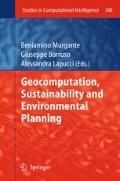Abstract
Assuming that urban planning aims the optimization of urban functioning and the well-being of citizens, questions like “how many people are living in the city?” and “where do they live?” become key issues. In this work we utilized landscape metrics generated by the FragStats software for the estimation of population density out of census sectors in the mega city of São Paulo, Brazil. The metrics were calculated over an image from the QuickBird II sensor classified by the Maximum Likelihood algorithm. The accuracy of the classified image was analyzed qualitatively. Ordinary linear regression models were generated and formal statistical tests applied. The residuals from each model had its spatial dependency analyzed by visualizing its LISA Maps and by the Global Moran index. Afterwards, spatial regression models were tried and a significant improvement was obtained in terms of spatial dependency reduction and increase of the prediction power of the models. For the sake of comparison, the use of dummy variables was also tried and it became a suitable option for eliminating spatial dependency of the residuals as well. The results proved that some landscape metrics obtained over high resolution images, classified by simple supervised methods, can predict well the population density at the area under study when using it as independent variable in spatial regression models.
Access this chapter
Tax calculation will be finalised at checkout
Purchases are for personal use only
Preview
Unable to display preview. Download preview PDF.
References
Anselin, L.: The Moran scatterplot as an ESDA tool to assess local instability in spatial association. In: Fischer, M., Scholten, H., Unwin, D. (eds.) Spatial analytical perspectives on GIS in environmental and socio-economic sciences. Taylor and Francis, London (1996)
Anselin, L.: GeoDa 0.95i Release Notes. Spatial Analysis Laboratory (SAL). Department of Agricultural and Consumer Economics, University of Illinois, Urbana-Champaign (2004)
Anselin, L., Bera, A.: Spatial dependence in linear regression models with an introduction to spatial econometrics. In: Ullah, A., Giles, D.E. (eds.) Handbook of applied economic statistics. Marcel Dekker, New York (1998)
Anselin, L., Florax, R.J.: Small sample properties of tests for spatial dependence in regression models: some further results. In: Anselin, L., Florax, R.J. (eds.) New directions in spatial econometrics. Springer, Berlin (1995)
Bailey, T.C., Gatrell, A.C.: Interactive Spatial Data Analysis. John Wiley and Sons, New York (1995)
Balk, D., Pozzi, F., et al.: The distribution of people and the dimension of place: methodologies to improve the global estimation of urban extent. In: Proceedings of the Urban Remote Sensing Conference, Tempe, AZ (2005)
Harvey, J.T.: Estimating census district populations from satellite imagery: some approaches and limitations. Int. J. Remote Sens. 23(10), 2071–2095 (2002)
IBGE – Fundação Instituto Brasileiro de Geografia e Estatística. In: Censo demográfico de 2000 (2002), http://www.ibge.br (access June 23, 2008)
Jannuzzi, P. M.: Projeções populacionais para pequenas áreas: métodos e aplicações (2004), http://www.abep.nepo.unicamp.br/docs/anais/pdf/2000/Todos/prot20_1.pdf (access August 18, 2008)
Liu, X.H., Clarke, K.: Estimation of residential population using high resolution satellite imagery. In: Proceedings of International Symposium on Remote Sensing of Urban Areas, Istanbul, Turkey (2002)
Li, G., Weng, Q.: Integration of remote sensing and census data for assessing urban quality of life: model development and validation. In: Weng, Q., Quattrochi, D. (eds.) Urban remote sensing. Taylor and Francis, Boca Raton (2007)
Liu, X., Herold, M.: Population estimation and interpolation using remote sensing. In: Weng, Q., Quattrochi, D. (eds.) Urban remote sensing, Taylor and Francis, Boca Raton (2007)
Lo, D., Weng, Q., et al.: Residential population estimation using a remote sensing derived impervious surface approach. Int. J. Remote Sens. 27(16), 3553–3570 (2006)
Mather, P.M.: Computer processing of remotely-sensed images: an introduction, 3rd edn. John Wiley & Sons, Chichester (2004)
Netter, J., Wasserman, W.: Applied linear statistical models. Irwin, Homewood (1974)
Reis, I. A.: Estimação da população dos setores censitários de Belo Horizonte usando imagens de satélite (2005), http://marte.dpi.inpe.br/col/ltid.inpe.br/sbsr/2004/11.18.18.39/doc/2741.pdf (access December 18, 2007)
Ribeiro, S. R. A,. Centeno, J .S.: Classificação do uso do solo utilizando redes neurais e o algoritmo MAXVER (2001), http://urlib.net/dpi.inpe.br/lise/2001/09.20.17.56 (access December 18, 2007)
Sutton, P.C., Elvidge, C.D., et al.: Building and evaluating models to estimate ambient population density. Photogramm Eng. Remote Sens. 69(5), 545–553 (2003)
UN-HABITAT (2006), http://www.unchs.org/programmes/guo/statistics.asp (access February 28, 2008)
Author information
Authors and Affiliations
Editor information
Editors and Affiliations
Rights and permissions
Copyright information
© 2011 Springer-Verlag Berlin Heidelberg
About this chapter
Cite this chapter
Novack, T., Kux, H., Freitas, C. (2011). Estimation of Population Density of Census Sectors Using Remote Sensing Data and Spatial Regression. In: Murgante, B., Borruso, G., Lapucci, A. (eds) Geocomputation, Sustainability and Environmental Planning. Studies in Computational Intelligence, vol 348. Springer, Berlin, Heidelberg. https://doi.org/10.1007/978-3-642-19733-8_7
Download citation
DOI: https://doi.org/10.1007/978-3-642-19733-8_7
Publisher Name: Springer, Berlin, Heidelberg
Print ISBN: 978-3-642-19732-1
Online ISBN: 978-3-642-19733-8
eBook Packages: EngineeringEngineering (R0)

